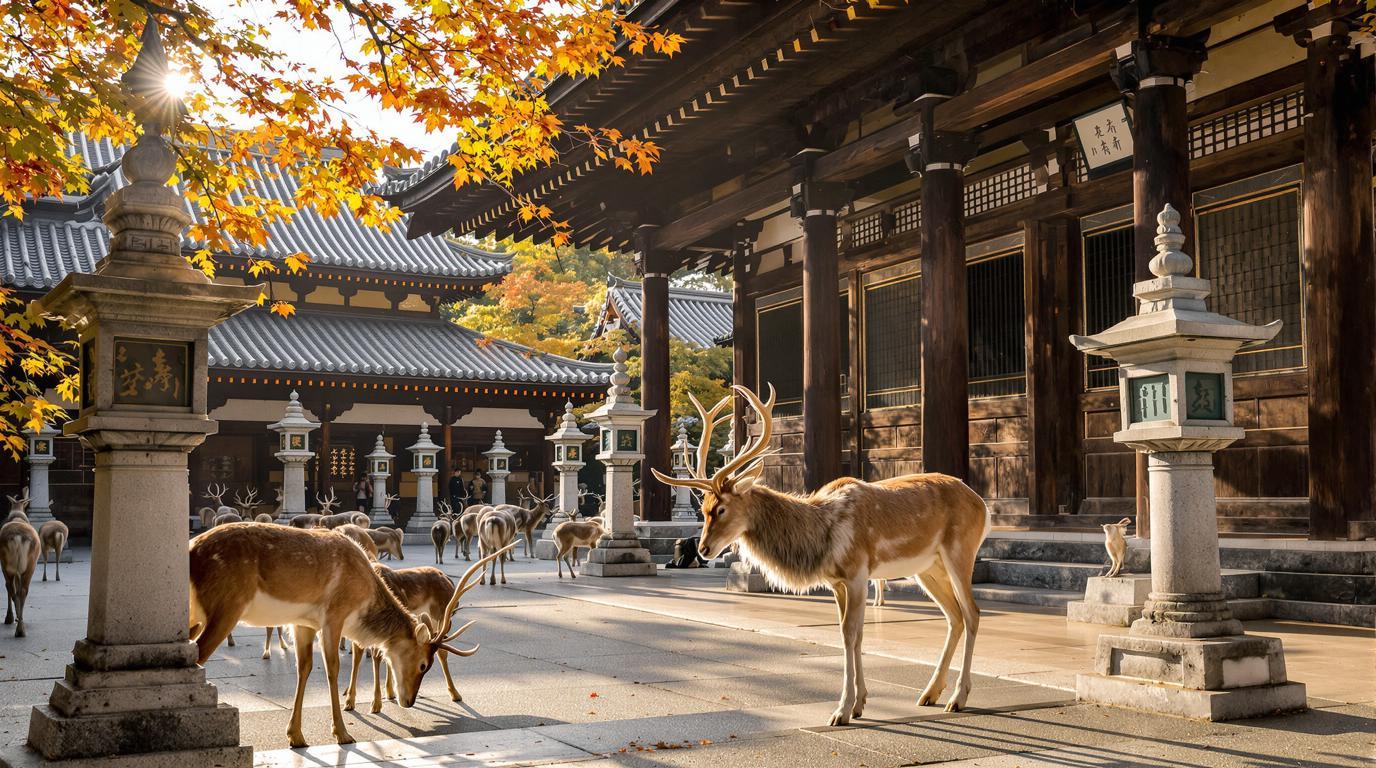# The Extraordinary City Where Deer and Humans Live as Neighbors
In Nara, Japan, an ancient city just south of Kyoto, over 1,200 wild deer freely roam streets, parks, and temples alongside 360,000 human residents. This isn’t a wildlife sanctuary or zoo—it’s simply everyday life in a place where deer have been considered divine messengers for over 1,300 years.
## The sacred messengers of Shinto gods
Dating back to the 8th century, Nara’s deer were believed to be messengers of the Shinto gods when a mythical deity Takemikazuchi arrived at Kasuga Shrine riding a white deer. This divine connection established their protected status—until 1637, anyone found killing a Nara deer would face execution.
“Our connection with the deer defines our cultural identity,” explains Kenji Yoshida, a fifth-generation Nara resident. “They’re not just animals but living symbols of our heritage and spiritual beliefs.”
## Urban deer that bow for cookies
Perhaps the most charming aspect of Nara’s deer is their learned behavior. These wild animals have adapted to city life in remarkable ways—most famously, by bowing to visitors. This isn’t random animal behavior but a learned response: deer bow to request “shika senbei” (deer crackers) sold throughout the city.
Unlike their completely wild cousins, Nara’s deer have developed surprisingly sophisticated social skills. They navigate crosswalks, rest in the shade of ancient temples, and generally maintain peaceful relations with the thousands of humans they encounter daily.
## When worlds collide: the reality of coexistence
Living alongside 1,200 wild animals isn’t without challenges. During rutting season (September-November), male deer become more aggressive. The Nara Deer Preservation Foundation routinely saws off antlers to prevent injuries. Deer-related injuries to tourists—mostly minor nips from impatient deer seeking crackers—number around 200 annually.
“Coexistence requires mutual respect. The deer may seem tame, but they remain wild animals with their own needs and boundaries,” warns park ranger Takumi Akimoto.
## A microcosm of human-wildlife relationships
Nara represents something increasingly rare in our modern world—a functioning urban ecosystem where humans haven’t completely dominated or excluded wildlife. For visitors seeking similar experiences, untouched natural paradises offer glimpses of humans and nature in harmony.
Unlike many tropical destinations where wildlife remains distant, Nara’s deer-human relationship evolved over centuries, creating unique cultural adaptations on both sides.
## When to visit this deer metropolis
Autumn brings spectacular foliage to Nara Park, but also coincides with mating season when deer become more unpredictable. Spring offers pleasant temperatures and cherry blossoms without aggressive deer behavior.
Like other pristine destinations facing tourism pressure, morning visits avoid crowds and offer more authentic interactions with deer.
## Beyond the deer: Ancient treasures
Nara’s unique deer population exists against the backdrop of Japan’s first permanent capital city (710-794 CE). Eight UNESCO World Heritage Sites include Todai-ji Temple housing a 15-meter bronze Buddha and the lantern-lined pathways of Kasuga-taisha Shrine.
“Visitors come for the deer but discover our 1,300 years of preserved history. The deer are guardians of these treasures,” notes historian Yukiko Tanaka.
## Conservation challenges in the modern age
Like the Dead Sea facing environmental challenges, Nara’s deer population faces modern threats. Increasing tourism has disrupted natural feeding patterns, with some deer becoming dependent on crackers rather than natural vegetation.
Conservation efforts include health checkups, population management, and education programs teaching tourists proper interaction techniques.
## The deer diet dilemma
Though deer crackers are tradition, veterinarians have concerns about their nutritional value. The crackers—made from wheat flour and rice bran—lack essential nutrients found in the deer’s natural diet of grass, leaves, and acorns.
Efforts to develop healthier crackers continue, balancing tradition with the animals’ wellbeing.
## A model for the future?
In a world where urban wildlife typically means raccoons raiding garbage cans, Nara offers an alternative vision. Like European paradises with ideal living conditions, Nara has created an environment where species coexist rather than compete.
As cities worldwide encounter increasing wildlife interactions due to habitat loss, Nara’s 1,300-year experiment in coexistence provides valuable lessons about creating shared spaces that benefit both humans and animals.
